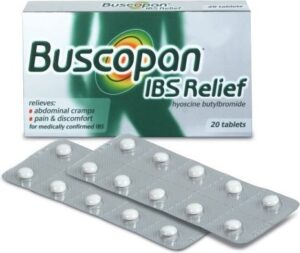BUSCOPAN
$45.49 – $129.79
Buscopan: An In-Depth Overview.
Indroduction;
Buscopan, known generically as hyoscine butylbromide, is a medication commonly used to relieve abdominal pain and discomfort caused by spasms in the gastrointestinal tract. It belongs to a class of drugs known as antispasmodics, which work by relaxing the smooth muscles of the gut. This article provides a comprehensive overview of hyoscine butylbromide, including its uses, mechanism of action, dosage, side effects, interactions, and answers to common questions.
What is Buscopan?
Buscopan is an antispasmodic medication that is primarily used to treat abdominal pain and discomfort associated with various gastrointestinal disorders. It is particularly effective in relieving symptoms of irritable bowel syndrome (IBS), diverticulitis, and other conditions that involve muscle spasms in the digestive tract. hyoscine butylbromide is available in various forms, including tablets, injections, and suppositories, making it versatile for different patient needs.

How Does Buscopan Work?
hyoscine butylbromide works by blocking the action of acetylcholine, a neurotransmitter that stimulates muscle contractions in the gastrointestinal tract. By inhibiting acetylcholine’s effects, hyoscine butylbromide relaxes the smooth muscles of the gut, reducing spasms and alleviating pain. This mechanism of action makes it particularly effective for conditions characterized by muscle cramping and discomfort.
Dosage and Administration
The dosage of hyoscine butylbromide varies depending on the formulation and the patient’s age and condition. For adults, the typical oral dose is 10 mg taken three times a day. In some cases, a healthcare provider may recommend a higher dose or more frequent administration. For children, the dosage is usually based on weight and should be determined by a healthcare professional. It is essential to follow the prescribing physician’s instructions and not exceed the recommended dosage.
Uses of Buscopan
Buscopan is primarily used for the relief of abdominal pain and discomfort caused by spasms in the gastrointestinal tract. Common indications include:
– Irritable Bowel Syndrome (IBS): hyoscine butylbromide is often prescribed to manage the symptoms of IBS, including cramping and abdominal pain.
– Diverticulitis: This condition, characterized by inflammation of the diverticula in the colon, can cause significant abdominal pain, which hyoscine butylbromide can help alleviate.
– Other Gastrointestinal Disorders: hyoscine butylbromide may also be used for conditions such as gastritis, peptic ulcers, and biliary colic.
Side Effects of Buscopan
Like all medications, hyoscine butylbromide can cause side effects. Common side effects include:
– Dry Mouth: A common anticholinergic effect, leading to discomfort.
– Dizziness: Some users may experience lightheadedness or dizziness.
– Constipation: As a result of reduced gastrointestinal motility.
– Nausea: Some individuals may feel nauseous after taking Buscopan.
Serious side effects are rare but can include allergic reactions, difficulty urinating, and severe dizziness. If any severe side effects occur, it is crucial to seek medical attention immediately.

Contraindications and Precautions
hyoscine butylbromide is not suitable for everyone. Important contraindications include:
– Glaucoma: hyoscine butylbromide may increase intraocular pressure, worsening glaucoma.
– Myasthenia Gravis: Patients with this neuromuscular disorder should avoid Buscopan due to the risk of exacerbating symptoms.
– Prostatic Hypertrophy: Men with enlarged prostate may experience urinary retention when taking hyoscine butylbromide.
Before starting hyoscine butylbromide, patients should discuss their medical history with their healthcare provider to ensure it is safe for them.
Drug Interactions
Buscopan or reduce the effectiveness of treatment. Some notable interactions include:can interact with other medications, which may increase the risk of side effects
– Other Anticholinergics: Using hyoscine butylbromide with other anticholinergic medications can enhance side effects.
– Antidepressants: Certain antidepressants may increase the risk of side effects when taken with hyoscine butylbromide.
– Antihistamines: Some antihistamines can also have anticholinergic effects, leading to increased sedation and dry mouth.
Patients should inform their healthcare provider about all medications they are taking to avoid potential interactions.

Common Questions About Buscopan
1. What is Buscopan used for?
hyoscine butylbromide is primarily used to relieve abdominal pain and discomfort caused by spasms in the gastrointestinal tract, particularly in conditions like irritable bowel syndrome (IBS).
2. How does Buscopan work?
hyoscine butylbromide works by blocking acetylcholine, which reduces muscle contractions in the gastrointestinal tract, alleviating symptoms like abdominal pain and cramping.
3. What are the side effects of Buscopan?
Common side effects include dry mouth, dizziness, constipation, and nausea. Serious side effects are rare but can occur.
4. Can Buscopan interact with other medications?
Yes, hyoscine butylbromide can interact with other medications, particularly other anticholinergics, antidepressants, and antihistamines.
5. Is Buscopan safe during pregnancy?
The safety of hyoscine butylbromide during pregnancy has not been fully established, so it is essential to consult a healthcare provider.
Conclusion
hyoscine butylbromide is a valuable medication for managing abdominal pain and discomfort caused by gastrointestinal spasms. By understanding its uses, dosage, side effects, and potential interactions, patients can make informed decisions about their treatment options. As with any medication, it is crucial to follow the guidance of a healthcare provider to ensure safe and effective use. With ongoing research and a growing understanding of gastrointestinal disorders, hyoscine butylbromide remains an essential tool in the management of conditions like irritable bowel syndrome and other related disorders.
| Qty | 40.00 tablets, 100.00 tablets, 200.00 tablets |
|---|



Reviews
There are no reviews yet.